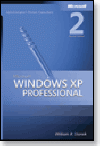
Home ◊ Books ◊ Training Seminars ◊ Registration

Home ◊
Books ◊
Training Seminars
◊ Registration
 Windows
XP Administrator's Pocket Consultant 2nd Edition
Windows
XP Administrator's Pocket Consultant 2nd Edition|
The Amazon.com Review
Ounce for ounce and dollar for dollar, the Pocket Consultant series from Microsoft Press is one of the best values around. The editors do a good job of recruiting competent authors and having them comply with well-thought-out style and formatting rules. Microsoft Windows XP Professional Administrator's Pocket Consultant is one of the gems of the series. Author William Stanek has spent time working with his subject--this book wasn't rushed to market to match the Windows XP release date--and he's good at revealing its administrative procedures clearly and concisely. The book is nicely indexed, so locating the section you need takes very little effort. This book--slightly larger than a paperback novel--is ideal for a harried administrator responsible for many different software products, as well as for consultants who need to learn how to use Windows XP Professional in a hurry. A particularly nice characteristic of Stanek's style: His skill at combining straight procedures ("Just follow these steps and it'll work") with supplementary information about options ("On the other hand, if you're doing something unusual, you might need to modify the standard procedure a bit"). As no real-life installation of Windows XP ever seems to match authors' ideas of normalcy, the supplementary information is critical. Screen shots are nicely handled as well. Their presence helps clarify what the text means, but they're not so large as to waste space. The Barnes & Noble Review The book's organized into four sections: essentials, core administration, networking, and optimization/recovery. In 350 pages, it manages to be remarkably complete. Want to use Windows XP's new Remote Assistance feature to resolve users' problems without leaving your computer? Prohibit users from setting up Internet Connection Sharing on your DNS domain? Set a new home page for all your users at once? Place custom content on each user's desktop? Use System Restore across a network? Lock the taskbar, so it can't be moved or lost? William B. Stanek walks you through all these tasks, and more. We could go on. Setting disk quotas. Managing security zones. Using notebook power schemes. Rolling back troublesome driver versions. Checking the status of a LAN connection. Configuring the synchronization of offline files. If you need to do it as a manager or support professional, there's no faster way to find out how.
FROM THE PUBLISHER
The practical, portable guide to Windows® XP
Professional!
Whether you support 50 desktops or 5000, this indispensable guide provides fast answers for the day-to-day administration of the Windows® XP Professional operating system. This pocket-sized resource zeroes in on essential desktop support issues and procedures—delivering critical details through quick-reference tables, step-by-step instructions, and lists. It's the precise information you need to solve problems and get the job done—whether you're at your desk or in the field! Get fast facts to:
|
Part I, “Microsoft Windows XP Professional Essentials,” covers the fundamental tasks you need for workstation administration. Chapter 1 introduces key administration tools, techniques, and concepts. Chapter 2 covers customizing system and environment settings. Chapter 3 explores hardware and device management. Chapters 4 and 5 will focus on customizing the Windows desktop. You’ll learn how to manage themes, color schemes, toolbars, and more. Finally, Chapter 6 discusses how to install, manage and maintain programs.
In Part II, “Microsoft Windows XP Professional Core Administration,” you’ll find the essential tasks for managing access, permissions, and more. Chapter 7 discusses techniques you can use to manage user access to systems and configure global settings. Chapter 8 zeroes in on administration issues that are specific to laptops and traveling users. The chapter details considerations you should make when configuring laptops, such as power management, hardware profiles, and networking. Group Policy is the subject of Chapter 9. In this chapter, you’ll find extensive lists that tell you exactly what policies you should use to manage permissions, rights, and capabilities. Chapter 10 discusses partitioning, monitoring and optimizing drives. Chapter 11 explains how to configure shared folders and printers. Chapter 12 discusses additional file and folder options including offline files, shadow copies and disk quotas.
Part III, “Microsoft Windows XP Professional Networking, Optimization, and Security” focuses on networking techniques and tasks, as well as on techniques you can use to improve performance and resolve problems. Networking is the subject of Chapter 13, which examines local area network settings. You’ll find a complete discussion of installing and configuring TCP/IP networking. The chapter also covers troubleshooting networking and provides steps for performing detailed network diagnostics. Chapter 14 moves from corporate network environments to mobile environments, examining dial-up networking, wireless client connections and remote access with virtual private networks (VPNs). Chapter 15 explains how to configure Internet options, such as default applications and trusted sites. You’ll also learn how to customize Internet settings through Group Policy. In Chapter 16, you’ll learn how to improve system performance, optimize drives, and enhance data security. You’ll also learn how to resolve Windows XP errors and schedule routine maintenance tasks. In Chapter 17, you’ll learn how to use Remote Assistance to remotely troubleshoot problems with devices, applications, and the Windows operating system itself. You’ll also learn how to troubleshoot problems with startup and shutdown, and how to create and use Restore Points. Hopefully, after reading these chapters, you’ll be able to improve the overall experience of your users and reduce downtime.
This book is available everywhere Microsoft books are sold. I hope you'll order the book from your favorite bookstore. All on-line bookstores carry the book as well. Here's the direct link to order the book at these bookstores:
Books ◊ Training Seminars/Locations ◊ Training Registration ◊ Self-Study Training
The obligatory copyright statement:
©William R. Stanek 2004-2005. All Rights
Reserved.